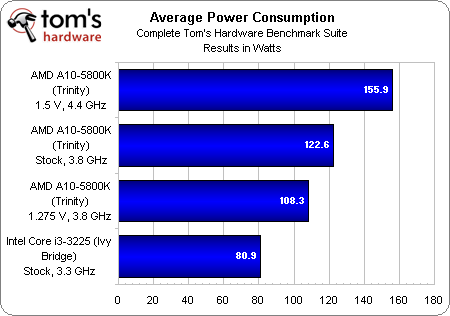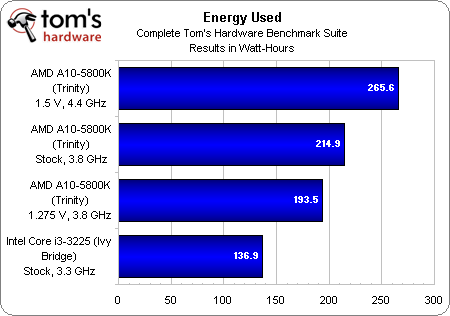AMD's Trinity APU Efficiency: Undervolted And Overclocked
We've been playing with AMD's Trinity APUs for four months, and they're just now being rolled out to the channel. This time, we take a look at the architecture's efficiency compared to a pair of Ivy Bridge-based Core i3s. Can A10 and A8 stand up to Intel?
Efficiency
Averaging together system power use from the previous page, the overclocked A10-5800K uses more than 155 W, which is 33 W higher than an A10-5800K at its stock settings.
Undervolting the APU to 1.275 V helps cut consumption by 14.3 W on average, though there is a cumulative performance hit of about two minutes (hardly anything when you’re talking about an almost two-hour run).
But none of the APUs finish the suite as quickly or average the same low power consumption of Intel’s Core i3-3225, which averages 80 W.
When you break down the time it takes to complete the many benchmarks in our suite, the difference between the fastest and slowest chip is less than six minutes.
This chart is an unlikely representation of something AMD keeps trying to pound into our heads: the nebulous idea of experience. Will you notice six minutes over the course of 20 back-to-back demanding tasks? Almost certainly, no. That’s the idea of “good enough” x86 performance. Will you notice the difference in gaming performance illustrated last week, though? When it means the difference between playable frame rates at 1920x1080 or choppiness, then yes.
That doesn’t make the next chart any easier to swallow, though.
In watt-hours, an overclocked A10-5800K uses almost twice as much power as a Core i3-3225 to complete the same workloads. Enthusiasts in AMD’s camp are going to look at those numbers and claim they don’t care about a marginally-higher power bill (the light bulbs on either side of your garage, together, probably use as much power), so long as they get usable 3D performance, while the cool-and-quiet crowd will remind us that a 100 W APU requires more cooling. That could mean a faster-spinning fan or a larger heat sink. Either way, that piece of logic that shifts balance from x86 performance to graphics alacrity is going to cost you.
Get Tom's Hardware's best news and in-depth reviews, straight to your inbox.
Current page: Efficiency
Prev Page Power Consumption Next Page The Pursuit Of Balance Warms Our Hearts-
esrever Most PC are idle or semi idle when people have them on. 90% of the time I use my PC, I do web surfing or watch video or a text editor for work, my pc is not loaded with benchmarks 24/7. If you look at idle power consumption, the trinity APUs are amazing. They easily beat out intels offerings. If you are looking at the power consumption over a month, the trinity will be much more energy efficient than the i3 for most people.Reply
-
tacoslave man getting this in a 17inch laptop with a 12 cell battery would make it an instabuyReply -
mayankleoboy1 ReplyIn the end, then, both Intel and AMD are offering you an experience. Which one do you pick?
At this price point, i would choose AMD Trinity. -
cangelini esreverMost PC are idle or semi idle when people have them on. 90% of the time I use my PC, I do web surfing or watch video or a text editor for work, my pc is not loaded with benchmarks 24/7. If you look at idle power consumption, the trinity APUs are amazing. They easily beat out intels offerings. If you are looking at the power consumption over a month, the trinity will be much more energy efficient than the i3 for most people.Happy to set a couple of systems up and let you know what I find.Reply -
mayankleoboy1 AMD should team up with developer of 7zip to accelerate it on APU's. That will make Trinity look better. A lot of people use 7zip. And most of the installation setup exe files are compressed using LZMA algorithm.Reply -
mayankleoboy1 Chris, it would be great to see some benchmarks of applications that uses the new FMA3 instructions of the Piledriver.Reply -
cangelini esreverMost PC are idle or semi idle when people have them on. 90% of the time I use my PC, I do web surfing or watch video or a text editor for work, my pc is not loaded with benchmarks 24/7. If you look at idle power consumption, the trinity APUs are amazing. They easily beat out intels offerings. If you are looking at the power consumption over a month, the trinity will be much more energy efficient than the i3 for most people.So, it's probable that we're seeing a difference in configuration. It looks like Anand is using the Gigabyte A85X board and perhaps an older driver version. I'm on the MSI board and Cat 12.8, with a different Intel setup as well. On the Windows desktop, after 10 minutes on each config, I get 59 W for Intel and 67 W for AMD at idle.Reply -
techcurious Chris, for the sake of completeness, any chance you could undervolt the i3-3225 at stock speeds and run the power consumption/efficiency tests on it? ;) ...to reveal how low the i3 can be pushed with some tweaking as well, and create the opportunity for a more fair comparison with the undervolted Trinity results.Reply -
sarinaide Thanks Chris, another great article to pass time over. You really need to comment on the forums more and more so to help out against the blatent belligerence against what AMD are trying to achieve and how they are looking to achieve it.Reply
Hopefully this articale can start to filter around particularly for the budget users which A-series is premised to target.



